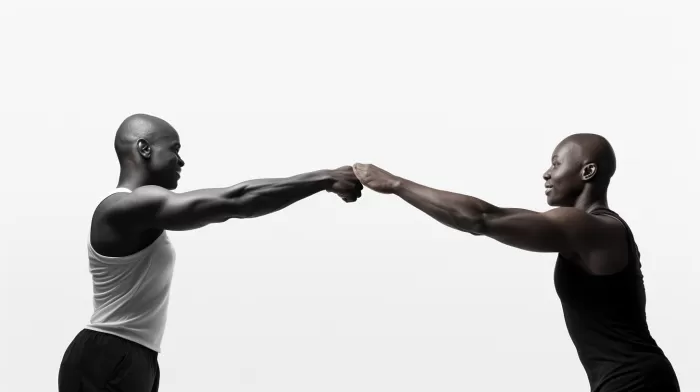Working out alone can be a challenge, especially when it comes to staying motivated and having the right equipment. That’s where having a workout partner comes in handy. Not only does working with a partner help with motivation and accountability, but their body can also act as the resistance you need to up your strength and fitness game. In this article, you’ll learn two simple yet highly effective techniques for strengthening and toning your chest, arms, shoulders, and back using your partner as resistance.
Partner Training Position
Begin by standing facing your partner, extending your arms and touching palms as if you’re giving each other a high-five. Position one foot forward and the other foot back, as though you’re in a short lunge or a walking step. Keep your elbows down and pulled in towards your body, ensuring the weight stays in your arms rather than being transferred to your chest. This positioning will also enable you to engage your latissimus dorsi (lats) muscles for more effective, varied tension.
Isometric and Isotonic Training
When it comes to partner training, both isometric and isotonic exercises can provide excellent workouts. Each type of training adds a specific load to your muscles to help strengthen them while also improving bone density. The primary difference between isometric and isotonic training lies in the movement (or lack thereof) of the muscles during exercise.
Isometric Exercise
Isometric exercises involve holding a load or tension at a stationary point for a period of time. You encounter these types of exercises every day, for example when holding a heavy object or lifting a child and keeping them at a stationary height. The more you hold a position, the more challenging it becomes for the muscles involved, making even lighter weights seem increasingly heavy.
Isotonic Exercise
In isotonic training, the load moves through the range of motion of the muscles involved. This is more common in weight training exercises such as barbell chest presses or dumbbell curls.
Next, let’s explore partner-friendly isometric and isotonic exercises to include in your workout routine.
Isometric Arm Press
Begin in the previously mentioned partner training position. This exercise focuses on isometric tension, where you and your partner press your hands into each other as if attempting to push the other person away. Anchor your body weight for stability and press your hand into your partner’s hand, who is providing the same level of resistance. This equal force will place tension on your arm and upper body muscles, helping to strengthen and tone them.
Hold the position for at least five seconds, and complete 10 repetitions before switching arms. The goal is to work together, neither partner trying to overpower the other.
Isotonic Arm Press
Now it’s time to incorporate isotonic tension with your partner. For this exercise, one partner provides constant forward pressure while the other creates consistent resistance. The resisting partner will allow the pressing partner to move through their range of motion and fully extend their arm. Then, switch roles. Alternate between holding tension and releasing slowly for about 20-30 seconds at a time. After completing a full set, switch arms and repeat.
These two exercises don’t require any equipment, and working with a partner adds a fun, motivating element to your workout routine while also increasing overall strength. So grab a partner, get moving, and start experiencing the benefits of these simple yet effective exercises today.



